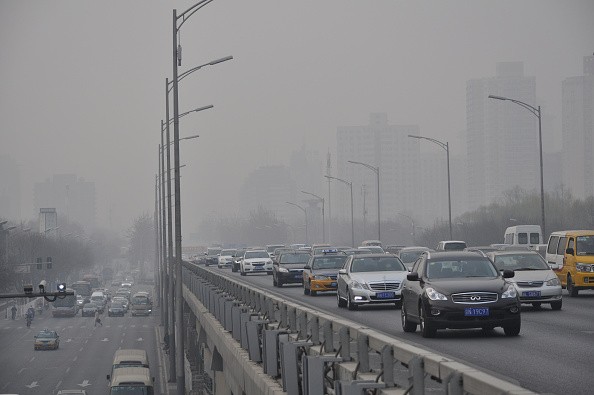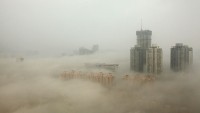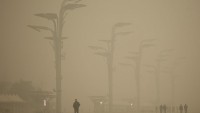Beijing Ramps up air Pollution Control Measures; Lists Smog as a 'Meteorological Disaster'
| Jenia Cane | | May 29, 2016 11:22 PM EDT |
(Photo : ChinaFotoPress/ChinaFotoPress via Getty Images) Vehicles run in the smog on March 17, 2016 in Beijing, China.
Beijing has listed smog as a meteorological disaster in line with the city government's efforts to further strengthen air pollution control measures.
With this recent move, smog will be included in the draft Beijing Meteorological Disasters Prevention and Control Regulation that is being reviewed by local authorities, China Daily reported.
Like Us on Facebook
The proposed pollution prevention and control regulation defines a meteorological disaster as damage primarily caused by haze, torrential rains, blizzards, sandstorms, drought or freezing conditions.
With the inclusion of smog in the proposed regulation, the nation's capital would need to improve its urban planning, particularly the design of its green zones and corridors, as a strategy to reduce the damage caused by smog.
Liu Zhengang, chief of the Beijing Legal Affairs Office, noted that smog has become a major concern for both the government and the public sector.
As Beijing's works towards enhancing its air pollution control initiatives, Liu said that it should take a cue from neighboring Tianjin and Hebei province that have already listed smog in their anti-pollution regulations.
So far, the State Council has not yet declared smog as a meteorological disaster.
According to Liu, the Chinese capital has become prone to meteorological disasters, which if left unaddressed, can cause huge economic losses accounting for at least one to three percent of the area's GDP.
"About 70 percent of the natural issues hitting the capital were meteorological ones," said Zhou Heping, deputy director in charge of rural affairs of the Standing Committee of Beijing Municipal People's Congress.
Based on data from the Beijing Municipal Environmental Protection Bureau, the capital had a 46 percent reduction in the concentration of PM2.5 - a fine particulate matter that poses health risks - in 2015, as compared to 2013.
However, the concentration of PM2.5 still exceeded national health standards by 1.3 times last year, and the city's residents saw 46 days of hazardous pollution.
Under the draft anti-air pollution and control measure, Beijing authorities need to focus on re-arranging its green zones, rivers, and roads, and at the same time, build corridors to disperse air pollutants.
TagsBeijing, Beijing Air Pollution Control, Beijing Meteorological Disasters Prevention and Control Regulation
©2015 Chinatopix All rights reserved. Do not reproduce without permission
EDITOR'S PICKS
-

Did the Trump administration just announce plans for a trade war with ‘hostile’ China and Russia?
-

US Senate passes Taiwan travel bill slammed by China
-

As Yan Sihong’s family grieves, here are other Chinese students who went missing abroad. Some have never been found
-

Beijing blasts Western critics who ‘smear China’ with the term sharp power
-

China Envoy Seeks to Defuse Tensions With U.S. as a Trade War Brews
-

Singapore's Deputy PM Provides Bitcoin Vote of Confidence Amid China's Blanket Bans
-

China warns investors over risks in overseas virtual currency trading
-

Chinese government most trustworthy: survey
-

Kashima Antlers On Course For Back-To-Back Titles
MOST POPULAR
LATEST NEWS
Zhou Yongkang: China's Former Security Chief Sentenced to Life in Prison

China's former Chief of the Ministry of Public Security, Zhou Yongkang, has been given a life sentence after he was found guilty of abusing his office, bribery and deliberately ... Full Article
TRENDING STORY

China Pork Prices Expected to Stabilize As The Supplies Recover

Elephone P9000 Smartphone is now on Sale on Amazon India

There's a Big Chance Cliffhangers Won't Still Be Resolved When Grey's Anatomy Season 13 Returns

Supreme Court Ruled on Samsung vs Apple Dispute for Patent Infringement

Microsoft Surface Pro 5 Rumors and Release Date: What is the Latest?












